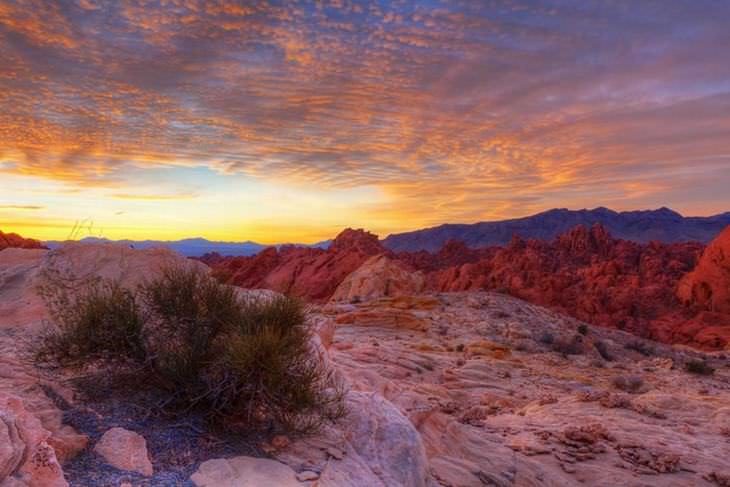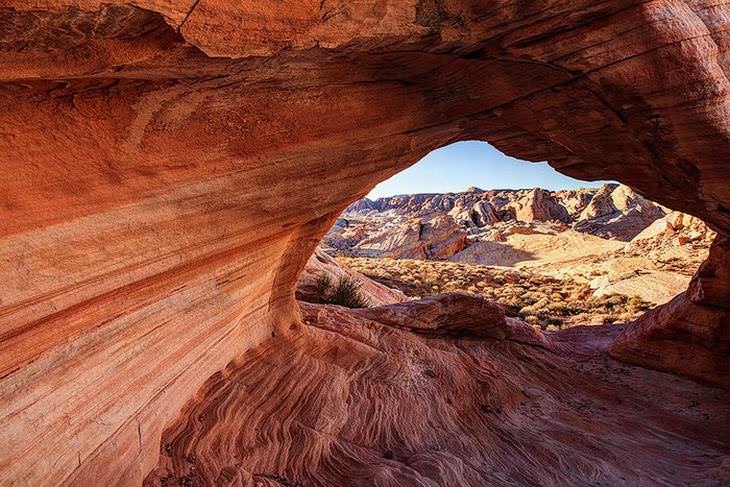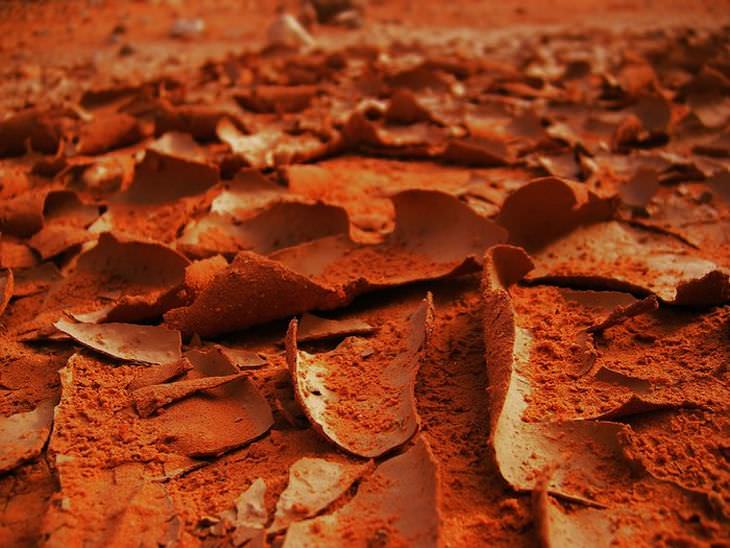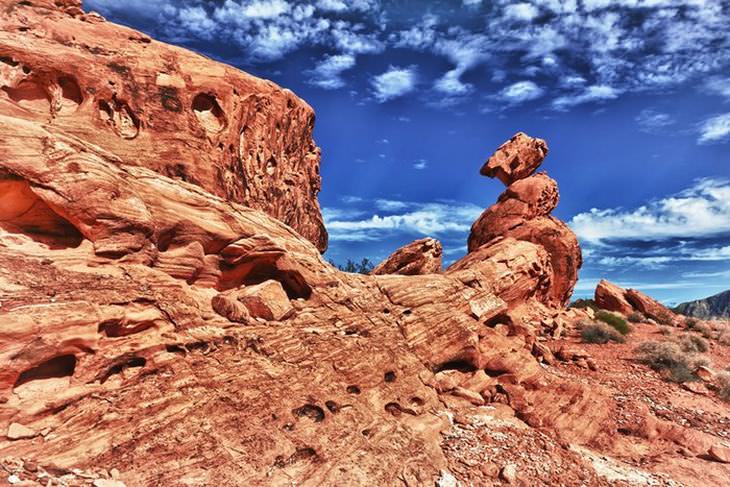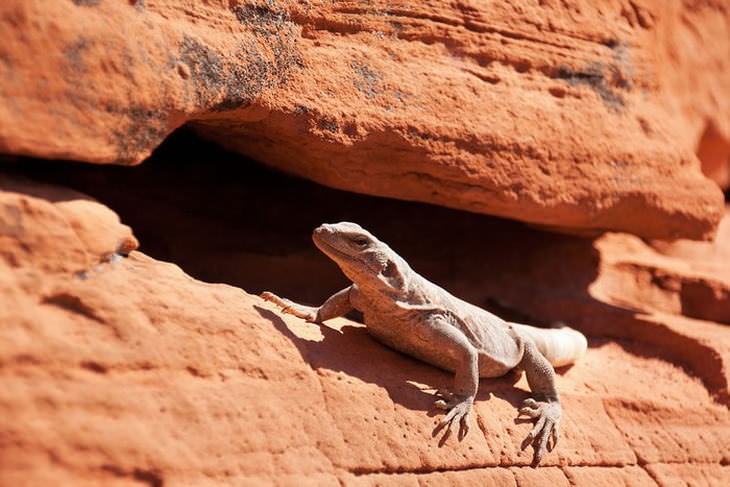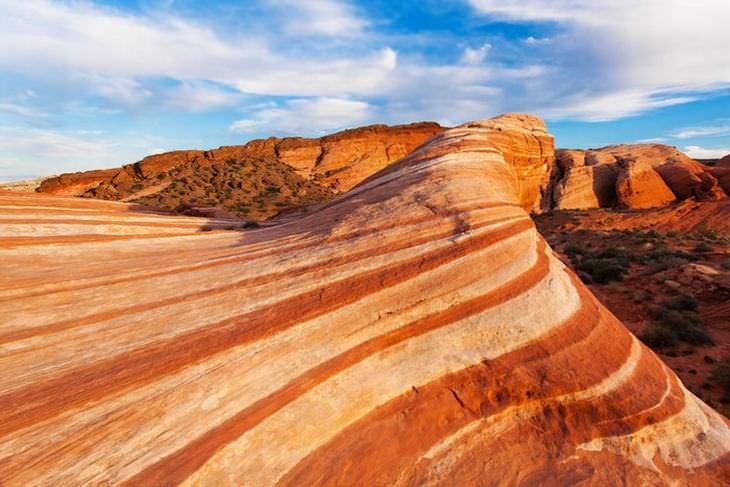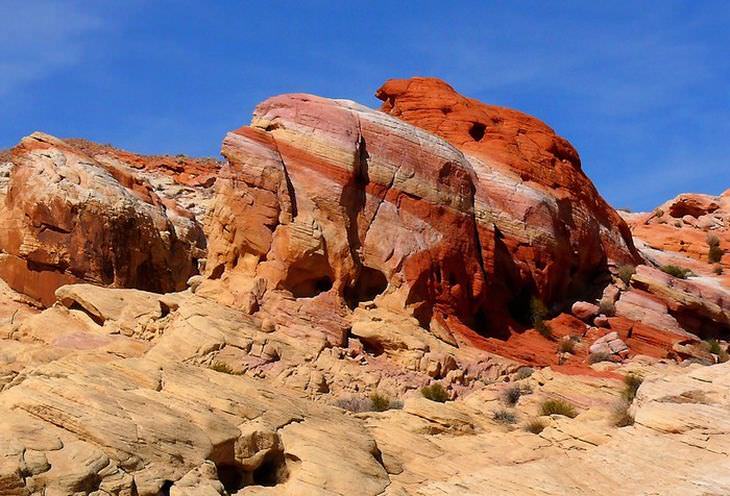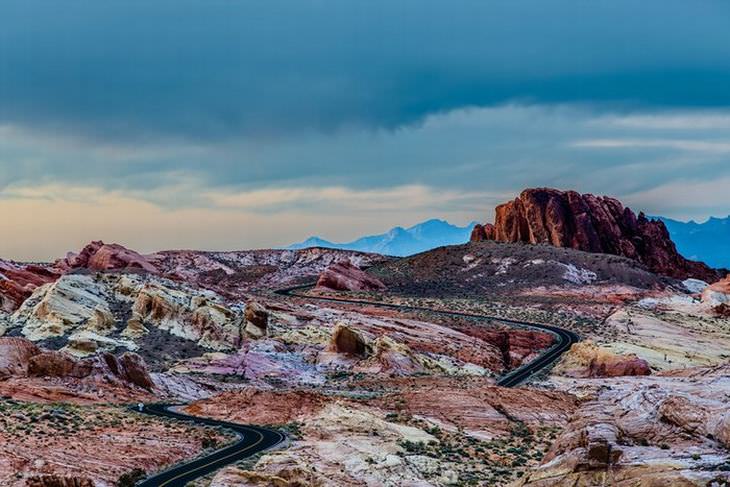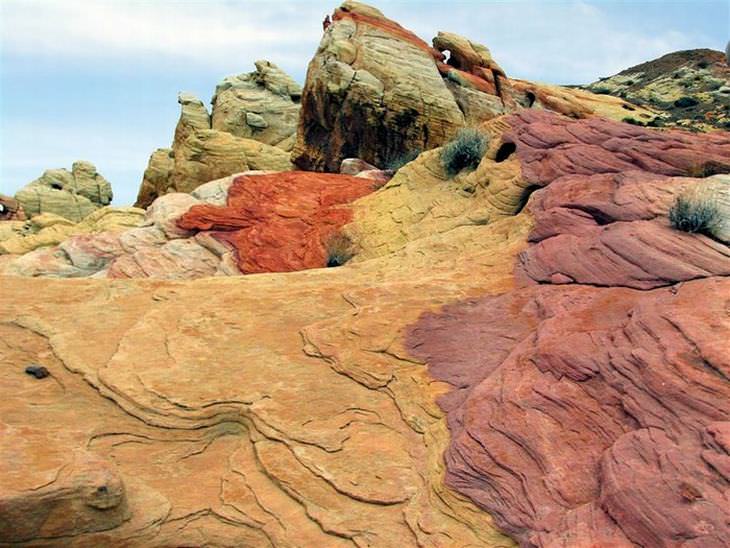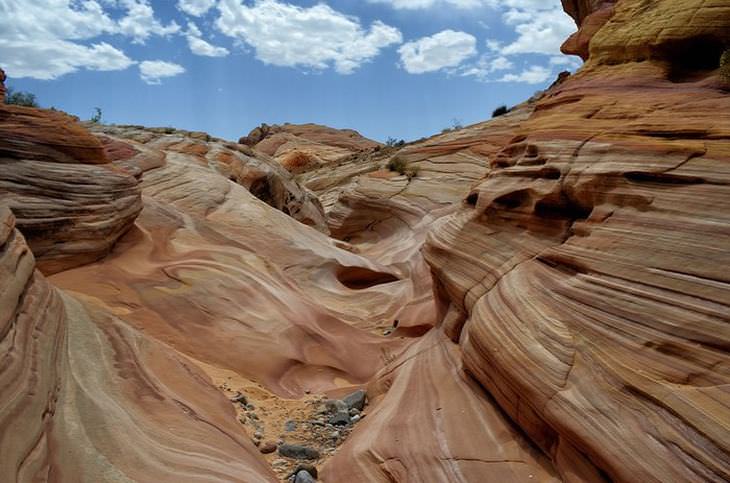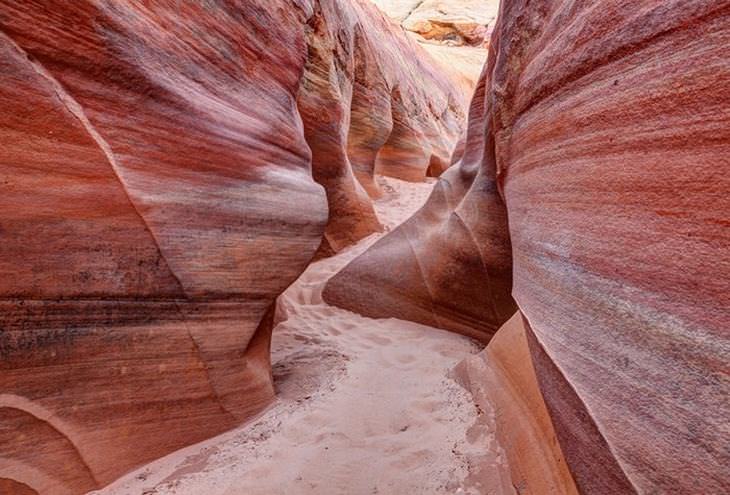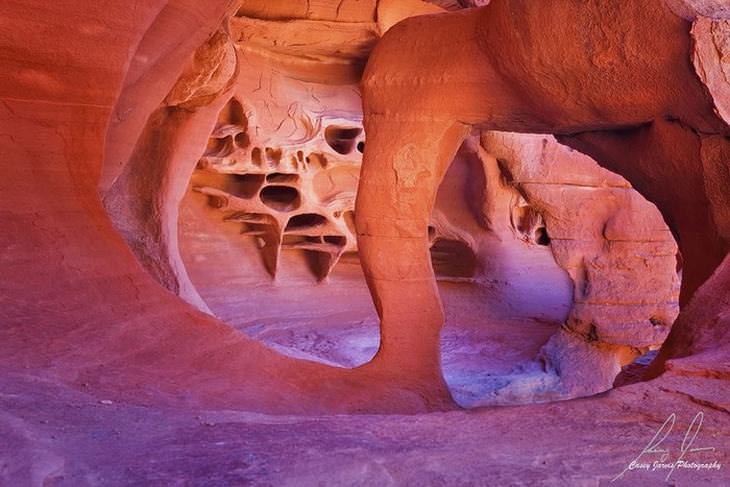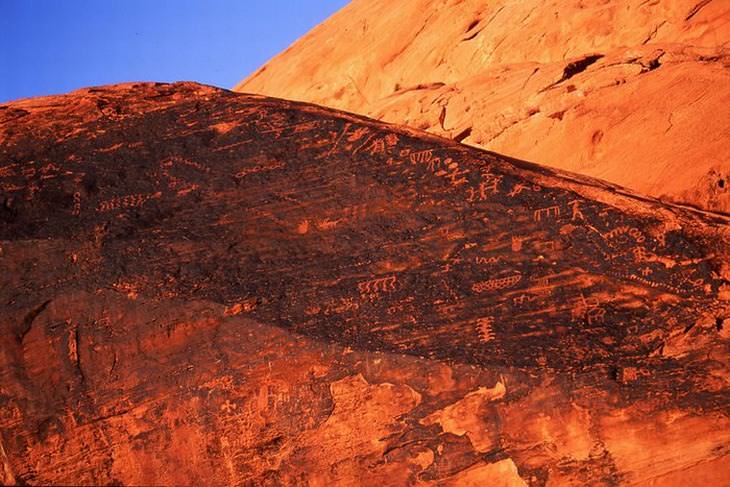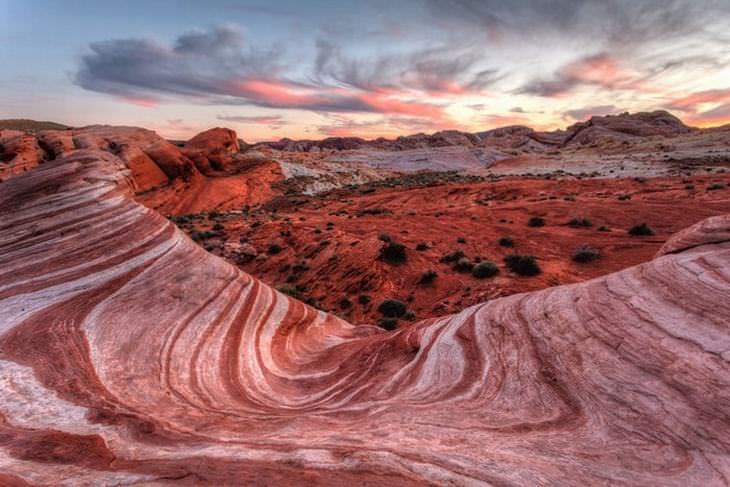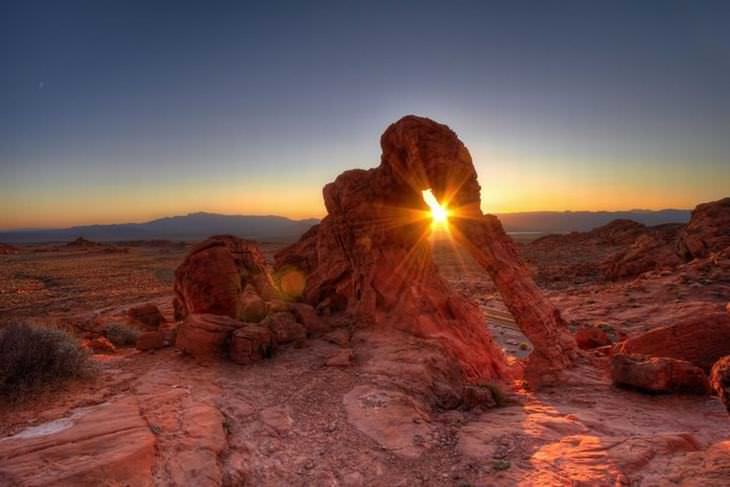
In the days before the first European colonists arrived, the Nevada desert was the home of the Ancient Pueblos (also known as the Anasazi). But before the Pueblos colonized the region, it was shaped by natural forces. Water, winds and tectonic movements molded the land, carving gorges and canyons in the earth and pushing mountains up.
Join me on a visit to one of the most beautiful places in North America.
Sunrise
As the sun rises over the desert, temperatures shift from about 50°F (10°C) to a sweltering 110°F (43°C).
Life
But this seemingly-dead land is actually the home of many animals, like this chuckwalla - the second-biggest lizard in the United States.
Colors and Shapes
Occasional water flow and constant winds blast these rocks, carving holes and arches through them, a process that has taken place over millions of years.
Water
Water is the rarest, most prized resource in the desert. It forms a small temporary oasis, which quickly dissipates in the heat of the day.
Petroglyphs
The native inhabitants of the land - the Pueblos, left many petroglyphs along the walls in various parts of the desert.
Evening
At sunset, the desert starts to cool down, and the sky starts to mimic the reds, pinks and yellows of the desert below.
Night
The desert is a natural deterrent for human habitation, leading to very low levels of light pollution. This leads to a spectacularly clear night-sky, where the splendor of the universe is visible again.
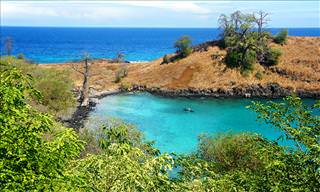
Welcome to the Tiny African Country You've Never Heard Of!
It's a shame that most people have never heard of Sao Tome and Principe. This stunning island nation has tons to offer visitors. Discover this magical place.
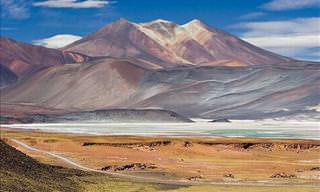
Have You Seen the Driest Place on Earth? It's Truly Beautiful
The Atacama desert in Chile is the driest place on Earth, averaging less than 1mm rainfall per year. Its unique landscapes are simply stunning to see.
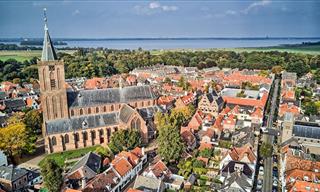
Secret Holland: 10 Towns Really Worth a Visit
The Netherlands is considered one of the most beloved countries in Western Europe, but to get to know it well, visit these 10 villages and towns.
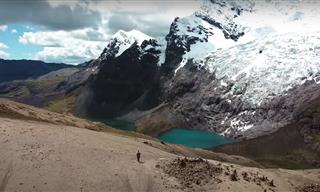 4:01
4:01
A Breathtaking Journey Above the Andes Mountains of Peru
This breathtaking video will take you on a magical journey above the Andes mountains in Peru.
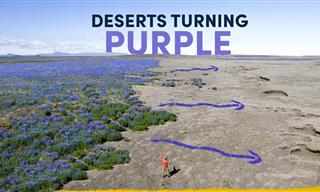 9:04
9:04
Iceland's Deserts are Flowering Again With This Species
A purple flower has taken over Iceland's deserts...
 5:45
5:45
Why Ingesting This Seemingly Innocent Plant is ILLEGAL
The Peyote, also known as the button cactus (for its cute button-like shape, of course), is not as innocent and harmless as it may seem.

A Huddle is a Cute Thing. A BIRD Huddle is Just the Cutest!
A huddle is a cute thing. A BIRD huddle is the cutest!
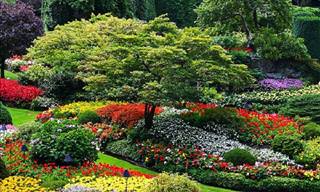
These Gardens Will Inspire You to Pay them a Visit
Take a walk through some of the most beautiful gardens from around the world.
 3:06
3:06
World's Biggest Snake: This Massive Anaconda Is 26ft-Long!
Scientists have just discovered the world’s biggest snake in Amazon rainforest.

Hummingbirds Come in the Most Beautiful Rainbow Colors!
There are hundreds of gorgeous species of hummingbirds. Have you spotted any of these near you?
 6:26
6:26
This Amusing Video Explains How Cats Land on Their Feet!
Have you ever wondered just how cats manage to safely land on their feet every time they fall or are dropped? Watch this video and wonder no more!
 4:21
4:21
Watch this Colorful Caterpillar Turn into a Stunning Moth!
Watch as this gorgeous caterpillar goes through the various stages of growth, to eventually emerge as a beautiful puss moth.

These Adorable Baby Animals Will Make You Smile
These tiny animals can all fit in one hand and are the cutest creatures you will see today.

Woman Captures Stunning Photos of Birds in Her Back Yard!
Although the weather and seasons in Germany and Michigan are quite similar, one woman realized that the birds are different. She took some great photos to prove this.
 4:15
4:15
Are These the Coolest 70 Year Olds Ever?
These women have made their livelihoods by hunting sea snakes on the coast of their island.
 3:51
3:51
Dr. Hodges - The Vet That Cures Exotic Cute Pets
In this video, we meet Monty, the pet axolotl. It's his first visit to the Vet!
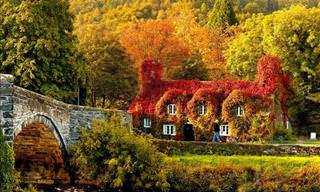
The 19 Most Breathtaking Fall Photos From Across the Globe
Let's celebrate the unique beauty of autumn! Admire this beautiful season in 19 different places around the globe with these stunning photos

Hilarious! Someone's Gonna Get Fired for This...
I've never seen so many pictures that seem too perfect to be real as here!
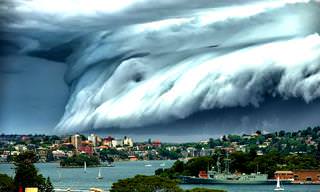
These Natural Phenomena Will Leave You Completely Aghast
Some of the natural phenomena in this world are completely unique and really need to be seen to be believed. Here are 25 phenomena

11 Adorable Polar Animals that Will Warm Your Heart
Adorable animals of the north and south poles

11 Incredible Animals with Even More Incredible Abilities!
Forget imaginary superheros and science fiction! These real animals have their own super powers and abilities such as camouflage, immortality and more!
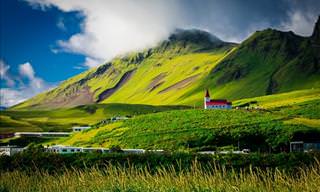
The 12 Least Densely Populated Places on The Planet
Behold a countdown of the top 12 least populated places on Earth. These places are ruled by nature and full of beautiful vast landscapes
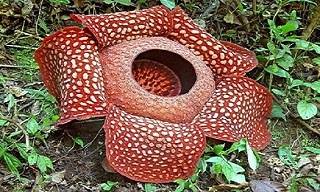
These Have Got to Be Some of the World Strangest Plants
In this world there are pretty plants and then there are talented and bizarre plants. These 12 plants definitely fall into the latter category.

Jaw-Dropping Photos: The Wonderful Lives of Ladybugs
Here are some wonderful photos of ladybugs in their natural habitats. I always feel a childish wonder and thrill when can coax one onto my hand.

16 Photos That Showcase Our Planet’s Breathtaking Beauty
Check out these unbelievably picturesque photos from around the world.

The Reddest Reds In Nature Are Incredibly Beautiful
Red is arguably the most vibrant color of all, but have you ever spared a thought about the reddest reds in nature? Here are the top 10!
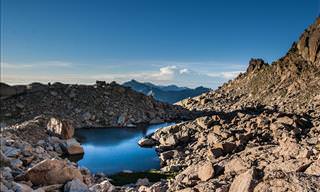
These Are the Best Nature Walks in the Entire World
There's no doubt that walking in nature is good for the soul, so imagine what it would do for you along the very best routes in the world. Here are 10 of them.

When Animals Love, We Get Wonderful Moments Like These
18 gorgeous moments of animals showing affection and love to each other in wonderful photography by Goran Anastasovski, see how they kiss, hug and show love.

15 Pictures Depicting the Rare Wonders of Nature
In this article, we display 15 unique photos of various natural phenomena - from rare eye colors to beautiful rock formations, and even albino plants.

Discover the World of Beautiful Wild Cats
These cats may make you want to pet them, but be advised - these are all rare and highly feral breeds. Maybe it's best to enjoy these 10 wild cats from afar...

Human Cultivation Changed These Plants Beyond Recognition!
These 8 familiar fruits and vegetables changed so much when people started cultivating them, you won't be able to recognize them!
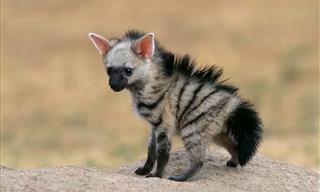
The Aardwolf May Not Sound Cute, But it CAN Be...
Ever heard of an aardwolf? If the answer to this question is no, then prepare yourself for one of the cutest animals you’re ever likely to see.

Here's What Happens When Animals Befriend People...
Here are 20 cute pictures of woodland animals that simply love to befriend people!
 6:17
6:17
How and Why Did Dolphins and Whales Return to the Ocean?
Like all mammals, whales were once a terrestrial animal with four legs. How and why did they become marine animals?
 6:02
6:02
Llamas Can Be Both Mean and Hilarious!
Llamas are some of the most hilarious animals on our planet. Watch this compilation video to find out why!

You Won't Believe the Equine Wonder in These Horse Photos
Wiebke Haas captures some of the world's most beautiful horses strutting their proud stuff in this superb collection of equine majesty.
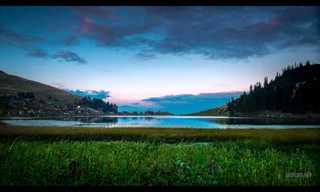 3:55
3:55
I Never Knew Bosnia Could Be So Breathtaking!
An incredible video of Bosnia & Herzegovina filmed for six months, displaying the natural beauty of this gorgeous country.

Tourists From All Over Flock to See this Beautiful Island
Wouldn't you want to visit this beautiful island, filled with nothing but flowers?
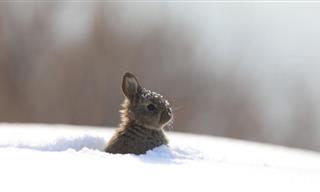
How Do Wild Animals Survive Winter Without Shelter?
Learn all the genius biological mechanisms animals use to survive winter in the wild - without central heating or warm socks.

Click to Transform Caterpillars Into Moths and Butterflies!
Both butterflies and moths have four stages of life, they go from the initial egg to a caterpillar, then to a cocoon and finally to a butterfly or moth. Watch these 18 interactive photos Before and After caterpillars transform.
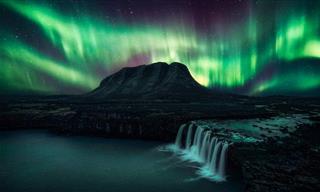
In Pictures: Northern Lights Photographer of the Year 2022
Behold the best images from the Northern lights photographer of the year 2022.
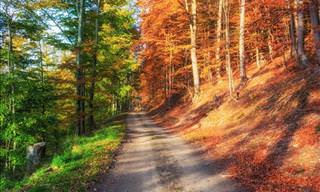
21 Gorgeous Reasons Nature Needs No Photoshop
You'll be impressed by 21 nature pictures that prove the world is beautiful the way it is if you only know where to look.
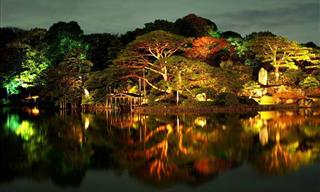
16 Stunning Gardens I'd Be Delighted to Stroll Through...
A stunning collection of 16 different landscape designs that will excite every nature lover out there.

You Won't Believe How a Walk in Nature Affects Our Brain
I was absolutely shocked to discover just how beneficial a walk in nature is for the brain. And upon reading #2 and #4, I couldn't wait to put my walking boots on and hit the park.

15 Magical Animal Moments That’ll Make You Smile All Day!
Animals sometimes take on the role of "models" and provide photographers with the opportunity to capture wonderful moments of magic that simply warm our hearts.
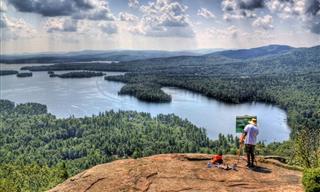
Feast Your Eyes: 50 Stunning Sceneries From 50 US States!
The US is full of magnificent places, in each and every state...



